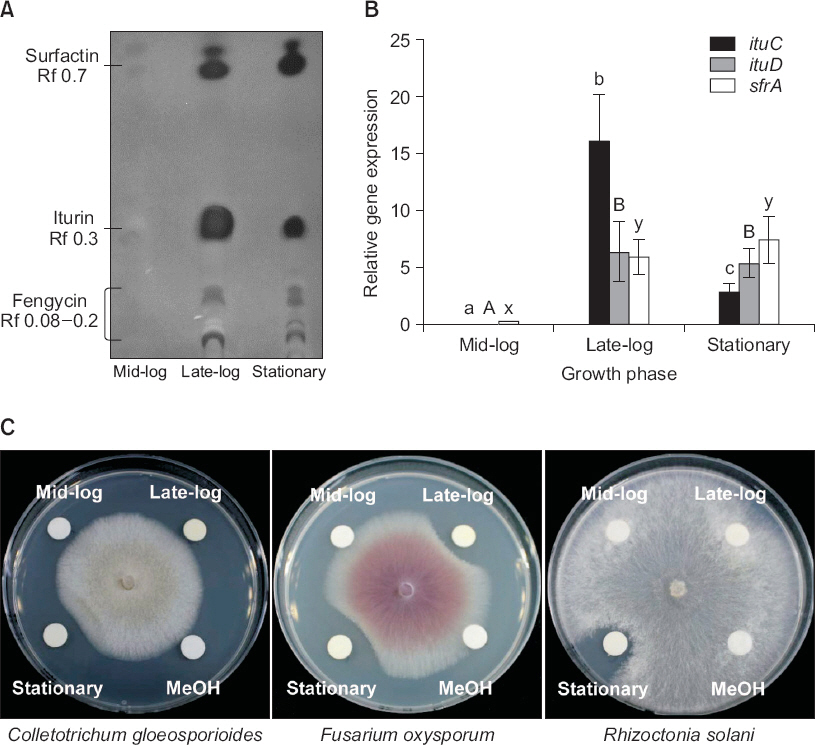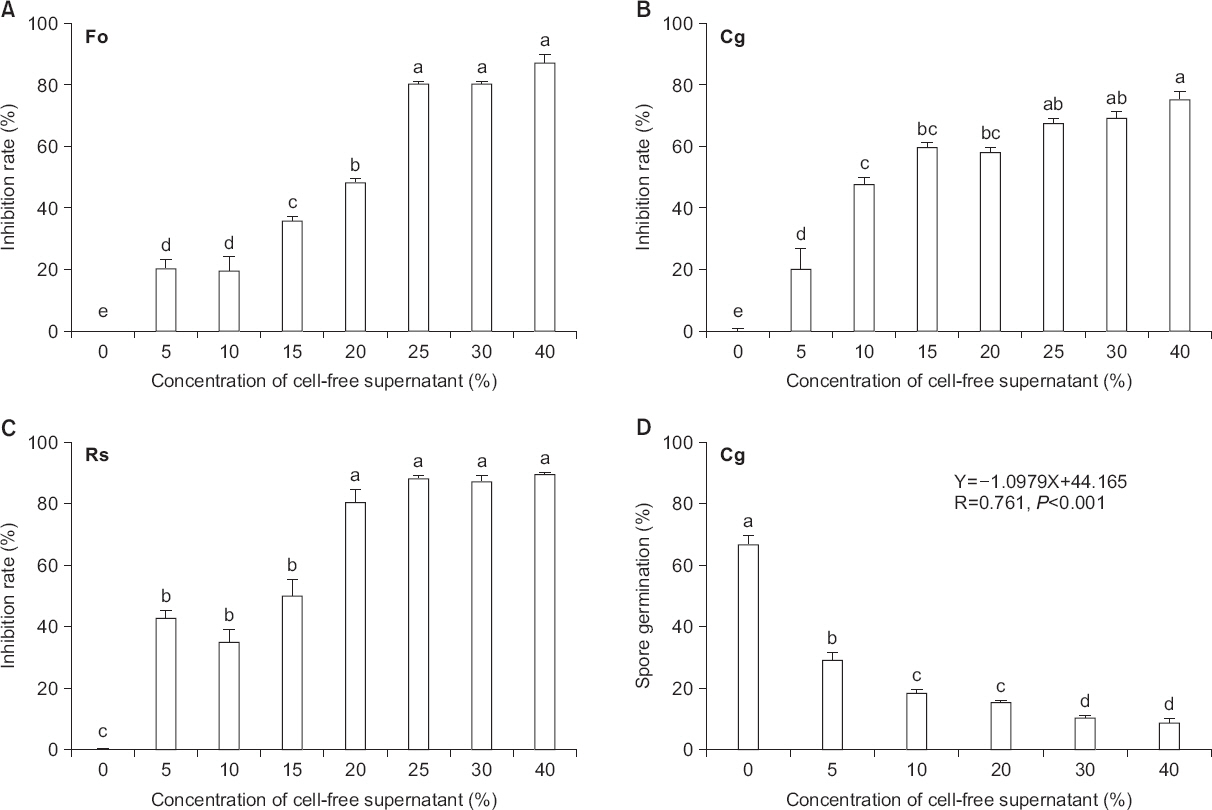Ahmad, F, Ahmad, I and Khan, M. S 2008. Screening of free-living rhizospheric bacteria for their multiple plant growth promoting activities.
Microbiol. Res 163: 173-181.


Ahn, J, Park, M. S, Kim, S. K, Choi, G. J, Jang, K. S, Choi, Y. H, Choi, J. E, Kim, I. S and Kim, J. C 2009. Suppression effect of gray mold and late blight on tomato plants by rhamnolipid B.
Res. Plant Dis 15: 222-229.

Arima, K, Kakinuma, A and Tamura, G 1968. Surfactin, a crystalline peptidelipid surfactant produced by
Bacillus subtilis: isolation, characterization and its inhibition of fibrin clot formation.
Biochem. Biophys. Res. Commun 31: 488-494.


Arrebola, E, Jacobs, R and Korsten, L 2010. Iturin A is the principal inhibitor in the biocontrol activity of
Bacillus amyloliquefaciens PPCB004 against postharvest fungal pathogens.
J. Appl. Microbiol 108: 386-395.


Bodour, A. A and Miller-Maier, R. M 1998. Application of a modified drop-collapse technique for surfactant quantitation and screening of biosurfactant-producing microorganisms.
J. Microbiol. Methods 32: 273-280.

Cao, X. H, Liao, Z. Y, Wang, C. L, Yang, W. Y and Lu, M. F 2009. Evaluation of a lipopeptide biosurfactant from
Bacillus natto TK-1 as a potential source of anti-adhesive, antimicrobial and antitumor activities.
Braz. J. Microbiol 40: 373-379.



Chitarra, G. S, Breeuwer, P, Nout, M. J, van Aelst, A. C, Rombouts, F. M and Abee, T 2003. An antifungal compound produced by
Bacillus subtilis YM 10-20 inhibits germination of
Penicillium roqueforti conidiospores.
J. Appl. Microbiol 94: 159-166.


Chopineau, J, McCafferty, F. D, Therisod, M and Klibanov, A. M 1988. Production of biosurfactants from sugar alcohols and vegetable oils catalyzed by lipases in a nonaqueous medium.
Biotechnol. Bioeng 31: 208-214.


Chowdhury, S. P, Hartmann, A, Gao, X and Borriss, R 2015. Biocontrol mechanism by root-associated
Bacillus amyloliquefaciens FZB42: a review.
Front. Microbiol 6: 780



Chung, S, Kong, H, Buyer, J. S, Lakshman, D. K, Lydon, J, Kim, S. D and Roberts, D. P 2008. Isolation and partial characterization of
Bacillus subtilis ME488 for suppression of soilborne pathogens of cucumber and pepper.
Appl. Microbiol. Biotechnol 80: 115-123.



Govindasamy, V, Senthilkumar, M, Magheshwaran, V, Kumar, U, Bose, P, Sharma, V and Annapurna, K 2010.
Bacillus and
Paenibacillus spp.: potential PGPR for sustainable agriculture. In: In: Plant Growth and Health Promoting Bacteria, ed. by D. K Maheshwari, pp. 333-364. Springer, Berlin, Germany.

Huszcza, E and Burczyk, B 2003. Biosurfactant production by
Bacillus coagulans.
J. Surfact. Deterg 6: 61-64.

Katz, E and Demain, A. L 1977. The peptide antibiotics of
Bacillus: chemistry, biogenesis, and possible functions.
Bacteriol. Rev 41: 449-474.




Kim, P. I, Ryu, J, Kim, Y. H and Chi, Y. T 2010. Production of biosurfactant lipopeptides iturin A, fengycin and surfactin A from
Bacillus subtilis CMB32 for control of
Colletotrichum gloeosporioides.
J. Microbiol. Biotechnol 20: 138-145.


Kim, S. H, Lim, E. J, Lee, S. O, Lee, J. D and Lee, T. H 2000. Purification and characterization of biosurfactants from
Nocardia sp. L-417.
Biotechnol. Appl. Biochem 31: 249-253.


Kolter, R and Moreno, F 1992. Genetics of ribosomally synthesized peptide antibiotics.
Annu. Rev. Microbiol 46: 141-163.


Kumar, N. P, Swapna, T. H, Sathi Reddy, K, Archana, K, Nageshwar, L, Nalini, S, Khan, M. Y and Hameeda, B 2016. Draft genome sequence of
Bacillus amyloliquefaciens strain RHNK22, isolated from rhizosphere with biosurfactant (surfactin, iturin, and fengycin) and antifungal activity.
Genome Announc 4: e01682-15.




Lee, S. C, Jung, Y. J, Yoo, J. S, Cho, Y. S, Cha, I. H and Choi, Y. L 2002. Characteristics of biosurfactants produced by
Bacillus sp. LSC11.
Korean J. Life Sci 12: 745-751.

Leifert, C, Li, H, Chidburee, S, Hampson, S, Workman, S, Sigee, D, Epton, H. A and Harbour, A 1995. Antibiotic production and biocontrol activity by
Bacillus subtilis CL27 and
Bacillus pumilus CL45.
J. Appl. Bacteriol 78: 97-108.


Livak, K. J and Schmittgen, T. D 2001. Analysis of relative gene expression data using real-time quantitative PCR and the 2(-Delta Delta C(T)) method.
Methods 25: 402-408.


Marahiel, M. A, Nakano, M. M and Zuber, P 1993. Regulation of peptide antibiotic production in
Bacillus.
Mol. Microbiol 7: 631-636.


Mnif, I, Grau-Campistany, A, Coronel-León, J, Hammami, I, Triki, M. A, Manresa, A and Ghribi, D 2016. Purification and identification of
Bacillus subtilis SPB1 lipopeptide biosurfactant exhibiting antifungal activity against
Rhizoctonia bataticola and
Rhizoctonia solani.
Environ. Sci. Pollut. Res. Int 23: 6690-6699.



Mnif, I, Hammami, I, Triki, M. A, Azabou, M. C, Ellouze-Chaabouni, S and Ghribi, D 2015. Antifungal efficiency of a lipopeptide biosurfactant derived from
Bacillus subtilis SPB1 versus the phytopathogenic fungus
Fusarium solani.
Environ. Sci. Pollut. Res. Int 22: 18137-18147.



Mochizuki, M, Yamamoto, S, Aoki, Y and Suzuki, S 2012. Isolation and characterisation of
Bacillus amyloliquefaciens S13-3 as a biological control agent for anthracnose caused by
Colletotrichum gloeosporioides.
Biocontrol Sci. Technol 22: 697-709.

Montesinos, E 2007. Antimicrobial peptides and plant disease control.
FEMS Microbiol. Lett 270: 1-11.


Mota, M. S, Gomes, C. B, Souza Júnior, I. T and Moura, A. B 2017. Bacterial selection for biological control of plant disease: criterion determination and validation.
Braz. J. Microbiol 48: 62-70.


Mulligan, C. N, Mahmourides, G and Gibbs, B. F 1989. The influence of phosphate metabolism on biosurfactant production by
Pseudomonas aeruginosa.
J. Biotechnol 12: 199-209.

Nam, H. S, Yang, H. J, Oh, B. J, Anderson, A. J and Kim, Y. C 2016. Biological control potential of
Bacillus amyloliquefaciens KB3 isolated from the feces of
Allomyrina dichotoma larvae.
Plant Pathol. J 32: 273-280.



Ongena, M and Jacques, P 2008.
Bacillus lipopeptides: versatile weapons for plant disease biocontrol.
Trends Microbiol 16: 115-125.


Ongena, M, Jourdan, E, Adam, A, Paquot, M, Brans, A, Joris, B, Arpigny, J. L and Thonart, P 2007. Surfactin and fengycin lipopeptides of
Bacillus subtilis as elicitors of induced systemic resistance in plants.
Environ. Microbiol 9: 1084-1090.


Park, K, Dutta, S, Park, Y. S, Sang, M. K and Moon, S. S 2016. Induction of systemic resistance and tolerance against biotic and abiotic stress in chinese cabbage by cyclic peptides producing Bacillus vallismortis strain BS07M. In: In: Recent Trends in PGPR Research for Sustainable Crop Productivity, eds. by R. Z Sayyed, M. S Reddy and A Al-Turki, pp. 200-205. Scientific Publishers, New Delhi, India.
Peypoux, F, Bonmatin, J. M and Wallach, J 1999. Recent trends in the biochemistry of surfactin.
Appl. Microbiol. Biotechnol 51: 553-563.


Rahman, A, Uddin, W and Wenner, N. G 2015. Induced systemic resistance responses in perennial ryegrass against
Magnaporthe oryzae elicited by semi-purified surfactin lipopeptides and live cells of
Bacillus amyloliquefaciens.
Mol. Plant Pathol 16: 546-558.



Razafindralambo, H, Paquot, M, Hbid, C, Jacques, P, Destain, J and Thonart, P 1993. Purification of antifungal lipopeptides by reversed-phase high-performance liquid chromatography.
J. Chromatogr 639: 81-85.


Romero, D, de Vicente, A, Rakotoaly, R. H, Dufour, S. E, Veening, J. W, Arrebola, E, Cazorla, F. M, Kuipers, O. P, Paquot, M and Perez-García, A 2007. The iturin and fengycin families of lipopeptides are key factors in antagonism of
Bacillus subtilis toward
Podosphaera fusca.
Mol. Plant-Microbe Interact 20: 430-440.


Rozen, S and Skaletsky, H 2000. Primer3 on the WWW for general users and for biologist programmers.
Methods Mol. Biol 132: 365-386.


Singh, A. K, Rautela, R and Cameotra, S. S 2014. Substrate dependent in vitro antifungal activity of
Bacillus sp strain AR2.
Microb. Cell Fact 13: 67




Slepecky, R. A and Hemphill, H. E 2006. The genus
Bacillus: nonmedical. In: In: The Prokaryotes, 4: ed. by M Dworkin, pp. 530-562. Springer, New York, NY, USA.

Souto, G. I, Correa, O. S, Montecchia, M. S, Kerber, N. L, Pucheu, N. L, Bachur, M and García, A. F 2004. Genetic and functional characterization of a
Bacillus sp. strain excreting surfactin and antifungal metabolites partially identified as iturin-like compounds.
J. Appl. Microbiol 97: 1247-1256.


Stanghellini, M. E and Miller, R. M 1997. Biosurfactants: their identity and potential efficacy in the biological control of zoosporic plant pathogens.
Plant Dis 81: 4-12.


Stein, T 2005.
Bacillus subtilis antibiotics: structures, syntheses and specific functions.
Mol. Microbiol 56: 845-857.


Tendulkar, S. R, Saikumari, Y. K, Patel, V, Raghotama, S, Munshi, T. K, Balaram, P and Chattoo, B. B 2007. Isolation, purification and characterization of an antifungal molecule produced by
Bacillus licheniformis BC98, and its effect on phytopathogen
Magnaporthe grisea.
J. Appl. Microbiol 103: 2331-2339.


Touré, Y, Ongena, M, Jacques, P, Guiro, A and Thonart, P 2004. Role of lipopeptides produced by
Bacillus subtilis GA1 in the reduction of grey mould disease caused by
Botrytis cinerea on apple.
J. Appl. Microbiol 96: 1151-1160.


Varadavenkatesan, T and Murty, V. R 2013. Production of a lipopeptide biosurfactant by a novel
Bacillus sp. and its applicability to enhanced oil recovery.
ISRN Microbiol 2013: 621519




Vessey, J. K 2003. Plant growth promoting rhizobacteria as biofertilizers. Plant Soil 255: 571-586.
Yamamoto, S, Shiraishi, S and Suzuki, S 2015. Are cyclic lipopeptides produced by
Bacillus amyloliquefaciens S13-3 responsible for the plant defence response in strawberry against
Colletotrichum gloeosporioides?
Lett. Appl. Microbiol 60: 379-386.



Yang, H. J 2015. Biological control activities of an insect endo-symbiotic bacterium Bacillus amyloliquefaciens. KB3. M.S. thesis. Chonnam National University; Gwangju, Korea.
Yoshida, S, Hiradate, S, Tsukamoto, T, Hatakeda, K and Shirata, A 2001. Antimicrobial activity of culture filtrate of
Bacillus amyloliquefaciens RC-2 isolated from mulberry leaves.
Phytopathology 91: 181-187.


Yu, G. Y, Sinclair, J. B, Hartman, G. L and Bertagnolli, B. L 2002. Production of iturin A by
Bacillus amyloliquefaciens suppressing
Rhizoctonia solani.
Soil Biol. Biochem 34: 955-963.







 PDF Links
PDF Links PubReader
PubReader Full text via DOI
Full text via DOI Download Citation
Download Citation Print
Print






